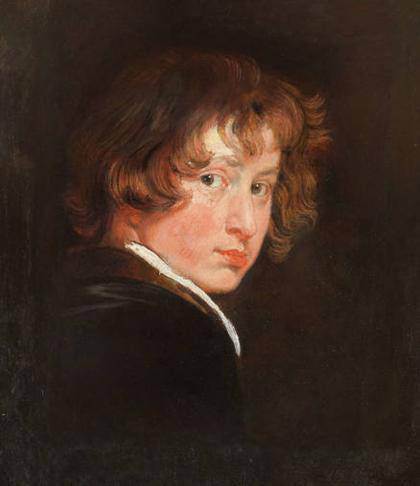
Anthony van Dyck: Self-portrait
Oil on panel, 43 x 32.5 cm, ca. 1615
Vienna, Gëmaldegalerie der Akademie der Bildenen Künste
Museo del Prado presents ‘The Young Van Dyck’ The Museo del Prado presents one of the largest exhibitions on Van Dyck (1599-1641) held to date and the first on his paintings and drawings to be organised in Spain. November 20, 2012 – March 03, 2013.]]>
Source: Museo del Prado
Anthony van Dyck is one of the few artists over the course of history to reveal an astonishingly precocious talent. This exhibition opens with a self-portrait of around 1615 executed when he was only fifteen or sixteen. It concludes in 1621, the date when he moved to Italy from his native city of Antwerp. During those six years in Antwerp and until the age of twenty-two, Van Dyck produced more than 160 works including portraits and medium sized compositions as well as around thirty ambitious, large-format paintings. His close relations with Rubens, who employed him as his assistant, gives rise to some of the most interesting questions relating to this period: why did Van Dyck produce some works that were as close as possible to those of his master but distanced himself in others, giving his figures a naturalistic appearance that was quite different to Rubens’s idealisation?
Explaining the evolution of this young and often contradictory painter in addition to revealing the remarkable quality of his work at this period are the aims of the present exhibition, which includes fifty-two paintings and forty drawings. This group will manifest Van Dyck’s precocious talent, which is evident not only in the large number of works that he produced but also in their quality. Had he only produced the works of his early period, Van Dyck could still be considered one of the most important painters of the 17th century.
Van Dyck, who was Rubens’s most talented pupil, set out to define his style at the very start of his career and this awareness of creating a personal approach was a new concept at the time. His earliest compositions are slightly hesitant and experimental in the depiction of the bodies, as evident in Christ’s Entry into Jerusalem (Indianapolis Museum of Art), The Lamentation (Ashmolean Museum, Oxford) and The drunken Silenus. They reveal Van Dyck’s experimental approach and a pronounced artistic personality that actively sought out new artistic resources in order to increase the impact of the work on the viewer.
In contrast, in works such as The Crowning with Thorns (Museo del Prado) Van Dyck reflects the powerful influence of the time that he spent working for Rubens (1577-1640), which is evident in that work in the similarity of the figures to those of Rubens, although once again it reflects an overall desire to define a personal and individual style. Van Dyck’s interest in textures and in rough, powerfully realistic bodies contrasts with the idealised beauty with which Rubens depicted his figures.
Related content
Landscape painter Martín Rico at Prado Museum (exhibition, 2012)
Follow us on:


